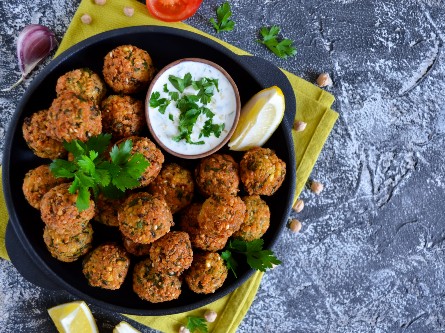
Inflammation is quite the buzz word in the health and wellness space recently. But what is it, and why does it matter?
Inflammation is one of the ways the body protects itself from harm. It is an important body process, but if it goes unchecked, it can lead to health problems.
Following a more anti-inflammatory eating pattern can help manage chronic inflammation. Below is some information on inflammation and tips for better anti-inflammatory eating habits.
What is inflammation?
Acute inflammation is our bodies' rapid response to an injury or infection, such as a cut to your finger. Redness, swelling, and pain are outward signs of acute inflammation. These are signs that the body is beginning the healing process.
Chronic inflammation is typically low grade but is persistent and can last for months or years. Chronic inflammation has been linked to a variety of different health conditions like:
- Heart disease
- High blood pressure
- Certain cancers
- Chronic pain
- Type 2 diabetes
- Anxiety
- Depression
- Certain autoimmune conditions
- Dementia
What causes inflammation?
There are many factors that can contribute to chronic inflammation. Some factors we have control over, and others we do not. These include:
- Dietary choices
- Smoking and tobacco use
- Exercise habits
- Sleep quantity and quality
- Alcohol use
- Persistent viral or bacterial infections
- Allergens and environmental pollutants in our air, water, and food
- Stress
As you can see, you can make lifestyle choices that lower chronic inflammation, rather than fueling it. In particular, our food choices have a significant impact on our health. Your diet as a whole has a large effect on the level of chronic inflammation in the body.
Learn ways to get better sleep and why it’s important for your health (Cultivating Health)
Get tips to reduce seasonal allergy symptoms and treatment options to help (Cultivating Health)
Explore 10 health benefits of meditation and how to focus on mindfulness (Cultivating Health)
Healthy eating tips to help reduce inflammation
1. Eat plenty of fruits and vegetables
Try for at least six, 1/2 cup servings each day. Include as much vibrantly colored produce as you can. Different colors have different benefits.
2. Choose high-fiber carbohydrates
Limit highly processed, low-fiber carbohydrates – like many white flour products (pasta, white breads, English muffins, bagels, crackers, and muffins), instant rice, instant potatoes, and most cold cereals.
Choose more high-fiber carbohydrates. This includes whole grains like brown rice, whole wheat products like bread and pasta, barley, oats, quinoa, buckwheat, and farro. You can also look for starchy vegetables, such as sweet potatoes, potatoes, winter squashes, beets, corn, beans, and peas.
Learn the health benefits of winter squash and ways you can cook them (Good Food Is Good Medicine)
3. Eat more fiber
Fiber is essential for our gut health, and therefore our overall health. Most Americans only get about 50% of the recommended daily amount of fiber. Try for 25 grams per day (for women) or 38 grams per day (for men).
Fiber comes from plant foods. There are two types of fiber and most fiber-containing foods are a combination of both types.
- Insoluble fiber does not absorb any water and provides bulk to the stool. This helps your digestion by keeping things moving and making your bowel movements soft and easy to pass. Examples of insoluble fiber are the skins, seeds, and stringy parts of fruits and vegetables, nuts and seeds, and the bran of whole grains.
- Soluble fiber absorbs water and forms a gel. This helps keep your blood sugar stable after a meal and keeps you fuller for longer, making meals more satisfying. It also helps lower cholesterol, promotes hormonal balance, and supports healthy bowel movements. Examples include beans and other legumes, flax or chia seeds, and whole grains like oats.
Both types of fiber are important, so include a variety of whole plant foods to help you get the recommended amount each day.
4. Choose plant-based and leaner animal protein sources
Plan to eat more plant-based sources of protein. This can include soy products (tofu, tempeh, edamame, soy milk), beans, lentils, nuts, and seeds. Choose lean animal proteins like fish, chicken, and turkey.
Try to limit red meat and avoid processed meats, and choose low-fat dairy products. When barbecuing or cooking meat, avoid charring as this creates compounds that can trigger inflammation.
5. Be conscious of your fat sources
Cook with unsaturated fats like extra virgin olive oil most often. Use neutral tasting oils for higher-heat cooking, like avocado oil, expeller-pressed canola or sunflower oil.
Stay away from trans fats. These are present in deep fried foods and anything with partially hydrogenated oils. Also, try to limit your intake of saturated fats. These include butter, fatty meats, poultry skin, processed meats, cheeses and other high-fat dairy products, coconut oil, palm oil, and cocoa butter.
6. Reduce the omega-6 to omega-3 ratio in the diet
Work in more omega-3 rich foods into your diet. These include omega-3 enriched eggs and wild-caught fatty fish like salmon, mackerel, anchovies, sardines, and herring. Plant-based sources include flax seeds, chia seeds, hemp seeds, and walnuts.
Limit your intake of omega-6 rich oils. Typically, these oils are mainly present in ultra-processed foods, including soybeans, safflower, corn, grapeseed, and cottonseed oils.
Explore this guide to healthy seafood and why you should eat more (Good Food Is Good Medicine)
7. Reduce your sugar intake
The average American consumes 17 teaspoons (68 grams) of added sugar daily, which is 2-3 times greater than the recommended limit. Keep your added sugar intake to less than 6% of your total calories. For men, that means no more than 9 teaspoons (36 grams) per day. For women, limit added sugars to less than 6 teaspoons (24 grams) per day.
Check labels the labels of the foods you're buying for sugar amounts. Keep in mind, 1 tsp sugar equals about 4 grams of sugar.
Avoid sugary drinks like soda, lemonade, sweetened teas, juices, and sweetened coffees. Limit eating desserts, pastries, candies, and other sweets. Other foods which often contain added sugars that you may not expect include bread, salad dressings, condiments, cereals, yogurts, pasta sauces, crackers, and chips. Honey and maple syrup are less refined forms of sugar, but they still count as added sugars.
Find out if fruit juice is really bad for you and your children (Good Food Is Good Medicine)
8. Limit or avoid alcohol
Alcohol disrupts the gut microbiome and can contribute to chronic inflammation. If you want an alcoholic drink, keep your average to one drink or less per day.
Learn about the health benefits of cutting alcohol (Good Food Is Good Medicine)
9. Add tea and spices with anti-inflammatory benefits into your diet
Black, white, and green teas are rich in antioxidants and polyphenols which can help combat inflammation. Some herbal teas also have anti-inflammatory benefits. Many herbs and spices also contain compounds that can help combat inflammation. Examples include rosemary, garlic, oregano, ginger, turmeric, cloves, nutmeg, cinnamon, and cayenne.
Learn more about the health benefits of tea and its effects on obesity (Good Food Is Good Medicine)
The key to anti-inflammatory eating is consistency
Keep in mind that the whole of your diet is greater than the sum of its parts. One meal will not make or break a healthy diet – it is consistency over time that matters. By keeping these tips in mind, you'll be adopting a healthy eating pattern that can help manage chronic inflammation and some of its associated health problems.
Written by registered dietitian Kathryn MacLean, MS.




